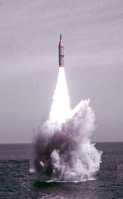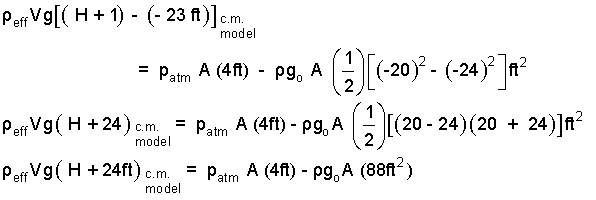| THERMO Spoken Here! ~ J. Pohl © | TOC NEXT ~ 126 |
Polaris Scale Model

Members of a rocketry club constructed a scale model of the submarine-launched ICBM, Polaris. Since the model was very light, the idea occurred that its buoyancy might accomplish the model's first stage of flight (without a rocket). Upon release at a depth in water, buoyancy of the model might project it from the water into air. As a test of this possibility they built a balsa-wood model which they secured to the bottom of a pond planning that its buoyancy would be the first stage. Simple tests are costly and time-consuming. Perform an energy analysis of the proposed event. Assume the event proceeds without friction.
Calculate the greatest possible elevation of launch above water of this first stage.
♦ We model the rocket model as an extended body. The schematic shows the initial position and anticipated final position upon launch. To do any calculation at all we must assume the event will involve no friction. One value of this restricted answer is that we can calculate it. The number we obtain be a height above which the missile will not go. So we use the numerical information of the schematic to determine the greatest, theoretically possible, second elevation of the model.

We take the model as our system. The energy equation is:

| (1)1 |
Kinetic energy of the model initially and at the peak height of flight equals zero. The only work is that of the pressure-force of water against the model top and bottom times their displacements.

| (2)2 |
Now put numbers into the equation (left to right). The model mass equals its effective density times volume. The final elevation of the model center of mass is: zc.m.,2 = H + 1 ft. The initial elevation was, zc.m.,1 = - 23 ft.
As regards work, the assumption of a frictionless event means the water will always contact the bottom (and top) of the model and exert a pressure-force always equal to the hydrostatic pressure times area. These pressure forces are displaced vertically. (Obviously no friction is pure fiction). We use the information above to write ΔPE. Also we write the first step in evaluation of the work.

| (3)3 |
Next we calculate the work of the event, one step at a time.

| (4)4 |
Recognizing that the values of integration over "z" are negative, we write the pressure expressions as "patm- ρg z" not, "patm + ρg z." The direction of the pressure force on the top is downward: (-K). Care must be taken in setting up the integral. The force on the bottom acts through the displacement, z, as: -24 ft ≤ z ≤ 0. The displacement of the top is: -20 ft ≤ z ≤ 0. We ignore any lifting effect of the air (once the model breaks the surface).

| (5)5 |
When the first integral is written in two parts, its second part sums with the second integral to be zero.

| (6)6 |
Be careful. Deal with units properly!

| (7) 7 |
Avoid unnecessary, potentially harmful algebra.

| (8) 8 |

| (9) 9 |
Obviously the balsa model will not attain the altitude calculated. There will be plenty of friction. This ideal calculation serves as the basis for more detailed, friction-inclusive calculations. To solve using assumed idealizations is the first step in solving real problems.
Polaris Scale Model

Members of a rocketry club constructed a scale model of the submarine-launched ICBM, Polaris. Since the model was very light, the idea occurred that its buoyancy might accomplish the model's first stage of flight (without a rocket). Upon release at a depth in water, buoyancy of the model might project it from the water into air. As a test of this possibility they built a balsa-wood model which they secured to the bottom of a pond planning that its buoyancy would be the first stage. Simple tests are costly and time-consuming. Perform an energy analysis of the proposed event. Assume the event proceeds without friction.
Calculate the greatest possible elevation of launch above water of this first stage.